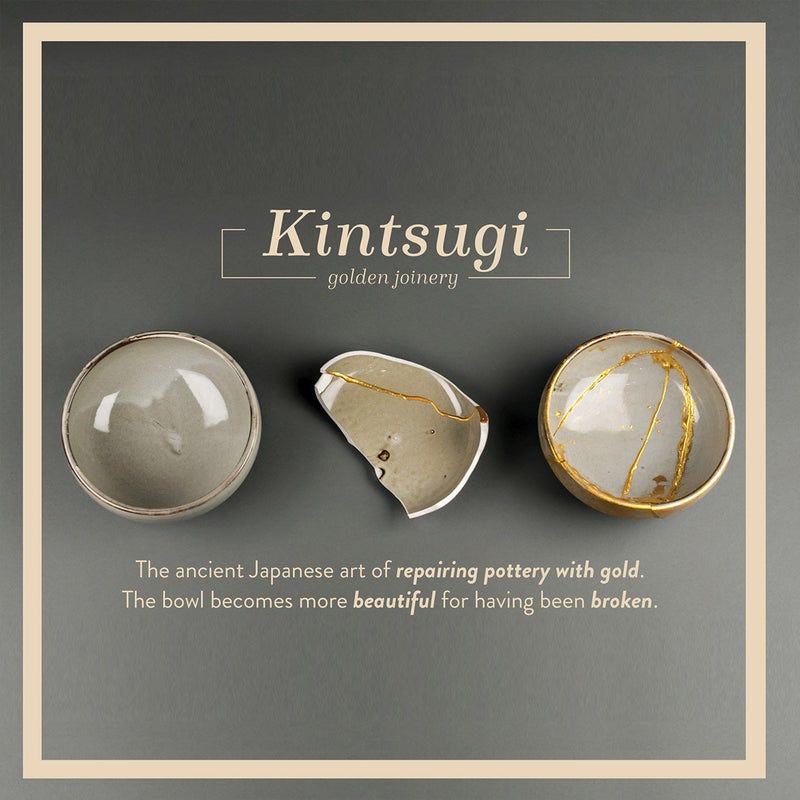Kintsugi Meaning

In a world that often prioritizes perfection and pristine appearances, there lies an ancient Japanese art form that celebrates imperfection, embracing the beauty of brokenness. Kintsugi, translated as “golden joinery” or “golden repair,” is not merely a technique of mending shattered ceramics; it embodies a profound philosophy that reveres flaws as part of the object’s history, elevating them to a state of heightened beauty.
Table of Contents
ToggleOrigins and Evolution
The roots of Kintsugi can be traced back to the 15th century in Japan, during the Muromachi period. Legend has it that the craft emerged when Ashikaga Yoshimasa, the eighth shogun of the Ashikaga shogunate, sent a beloved tea bowl to China for repairs. Dissatisfied with the unsightly metal staples used in the repair process, Japanese craftsmen sought an alternative method that would not only fix the broken pieces but also enhance the vessel’s aesthetic appeal.
Thus, Kintsugi was born
Initially practiced as a practical solution to mend broken pottery, Kintsugi gradually evolved into an art form that embodies profound philosophical principles. It reflects the Japanese aesthetic of wabi-sabi, which celebrates the beauty of imperfection, impermanence, and authenticity.
The Technique
At its core, Kintsugi involves repairing broken pottery by meticulously rejoining the fractured pieces with lacquer mixed with powdered gold, silver, or platinum. The process requires precision, patience, and a deep understanding of the material, as artisans delicately fuse the fragments together, emphasizing the cracks rather than concealing them.
Each fracture is highlighted with a gleaming seam of precious metal, turning the mended object into a stunning tapestry of history and resilience. What was once considered damaged beyond repair becomes a masterpiece, infused with new life and character.
Philosophy of Kintsugi
Beyond its technical intricacies, Kintsugi encapsulates profound philosophical concepts that resonate far beyond the realm of pottery. Central to its philosophy is the idea of embracing imperfection as a vital aspect of existence. Rather than hiding flaws or blemishes, Kintsugi encourages us to acknowledge and honor them, recognizing that our scars tell stories of resilience, growth, and transformation.
In a world that often values flawlessness and uniformity, Kintsugi serves as a poignant reminder that true beauty lies in authenticity and vulnerability. It challenges the notion of perfection, inviting us to reevaluate our relationship with impermanence and find beauty in the midst of brokenness.
Symbolism and Significance
Beyond its aesthetic appeal, Kintsugi holds symbolic significance that resonates on both personal and universal levels. The golden seams that adorn the mended pottery symbolize not only the process of healing but also the idea of embracing our flaws and transforming them into sources of strength and beauty.
Moreover, Kintsugi serves as a metaphor for life itself. Just as the broken pottery is transformed into something exquisite through the process of repair, so too can we find meaning and beauty in our own brokenness. It reminds us that our scars do not diminish our worth but rather enrich our journey, imbuing us with depth, resilience, and authenticity.
Conclusion
In a world that often seeks perfection and uniformity, Kintsugi stands as a powerful testament to the beauty of imperfection and the transformative power of resilience. It invites us to embrace our flaws, celebrate our scars, and find beauty in the broken pieces of our lives.
Through its elegant fusion of art and philosophy, Kintsugi not only revitalizes broken pottery but also revitalizes our perception of imperfection, inviting us to see the beauty in the cracks and cherish the journey that has shaped us into who we are. In a society that often strives for flawlessness, Kintsugi reminds us that true beauty lies in our authenticity, vulnerability, and the stories etched into the fractured pieces of our lives.





